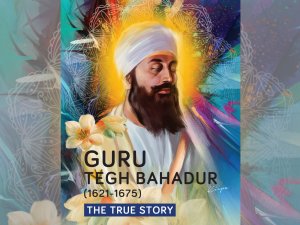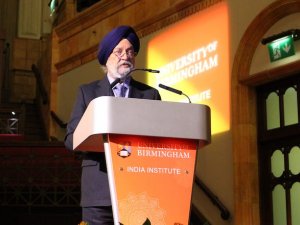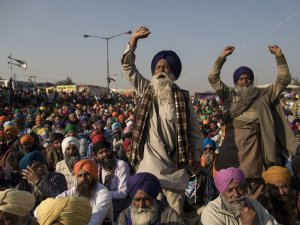Role of Sikh Women in 18th Century Khalsa Struggle - Lessons for Today [i]
[Article published in the Sikh Review in 2010 - probably August 2010 issue - is partly based on the author’s essay first published as souvenir booklet “Gurdwara Shahid Ganj Singh Singhania, Lahore” There are lessons for today.]
“All differences which arise between man and man in time of peace were effaced beneath the terrible levelling of the oppressor; all men had become brothers and all women sisters.” (Hari Ram Gupta )[ii]
Thursday, 24 December 2015: The pivotal role of a house-wife in the human family[iii] and the gender equality principle enshrined in Gurbani and Sikh tradition, empowered women in early Sikh history to contribute to the achievement of Khalsa temporal and ideological (miri-piri) objectives. In the last two centuries, that role has diminished due to Brahmanic influence on Sikh thought and institutions. There is an urgent need to reverse this negative trend.
Guru sakhis (anecdotes) and the history of the 18th century people’s revolution to overthrow tyrannical nawabs and rajas under the Mogul empire, continually refer to the strong influence and contribution of women from Bebay Nanaki and Bibi Bhani to Mata Sundri ji. Sikh women are remembered for their great sacrifices during this period. Later, during the golden period of the Khalsa raj, they continued to play a leading role in Sikh affairs.
There are lessons to be learnt from that period to promote gender equality in the 21st century Sikh institutions and households.
Before returning to the main topic, it is important to be clear about the Gurmat basis for gender equality, which cannot be denied under any excuse. The general equality principle in Sikhi derives from the spiritual sisterhood of humankind. All are soul-brides of the One Timeless Lord (Akal Purakh) seeking union by aspiring to the status of “sohagan” i.e. one who is beloved of her husband and is respected in the family. A woman who becomes the “sohagan” has been referred to as “batees sulakhani” in Gurbani i.e. one blessed with the proverbial 32 qualities[iv]. All men and women can be “sohagan” if they have the qualities necessary to please the Lord. Therefore, man-woman division is a mere technicality in this respect. It matters not whether one has the body of a man or a woman. The path to achieve blissful union with the Timeless Reality (Akal Purakh) is the same for all.
The oft quoted Shabad concluding, “Why call her bad, who gives birth to kings”[v] to prove gender equality, has less relevance. Not calling a woman “bad” is not the same as unconditional acceptance of man-woman equality under the general Gurbani-based human equality principle above. In fact, as implied by Prof Prabhjot Kaur elsewhere, by stressing the need to develop feminine qualities, Gurbani gives women a head start in achieving the ultimate goal of this human life![vi]
Guru Amardas (1479 – 1574 Guruship from 1552) carried out major reforms in ensuring that women enjoyed equal congregational (sangat, pangat and sewa ) status with men. The name of Guru ji’s daughter, Bibi Bhani, dedicated to Guru seva, is mentioned in connection with Gurgadhi succession. Mata Sundari and Mata Sahib Deva(n) gave guidance and issued Hukamnamas to the Khalsa during a most challenging period in Sikh history after Baba Banda Singh’s exemplary martyrdom in true Sikhi spirit at Delhi in 1716. Clearly, much progress had been made by that time regarding the participative role of women in Panthic affairs since the first women missionary appointees by Guru Amardas ji. Both Mata ji’s Hukamnamas were obeyed by Khalsa Panth. (Those against bibia(n) doing religious or Kirtan seva at Darbar Sahib need to open their eyes to these historical facts. )
 The above is the ideological and traditional background to the Sikh women’s immense contribution to the 18th century people’s war of independence from tyrannical rule, led by the Khalsa. Mai Bhago (Bhag Kaur) had wielded the sword and the spear alongside Guru Gobind Singh ji, dispelling all doubts that women may not be able to stand by their brother warriors in the battlefield.
The above is the ideological and traditional background to the Sikh women’s immense contribution to the 18th century people’s war of independence from tyrannical rule, led by the Khalsa. Mai Bhago (Bhag Kaur) had wielded the sword and the spear alongside Guru Gobind Singh ji, dispelling all doubts that women may not be able to stand by their brother warriors in the battlefield.
The egalitarian Gurbani ideology empowered Sikh women to run households during the prologed absence of men freedom fighters, and thus added vastly to the strength of the armed struggle, otherwise denied to their adversaries. It is significant that “Singh-Singhania” (Sikh men and women) are mentioned together in the daily Ardaas (supplication) - a historical milestone record in progress - agreed by the Khalsa Panth after Guru Gobind Singh (1666 – 1708), which remembers the martyrdoms (Jinna dharam het sis dittay), and the pain and hardships endured. It is a reminder of gender equality enshrined in Gurbani and actually earned by Sikh women fighting dharam-yudh alongside men in the field.
Supported by the people of Punjab, Baba Banda Singh
Bahadur showed that Guru Gobind Singh’s Khalsa was more than a match for the oppressive local rulers and the waning Mogul empire, and capable of realising Guru Gobind Singh’s political mission of in gareeb Sikhan ko dio(n) patshahi (I shall make these poor Sikhs rulers) and Raj karega Khalsa (the Khalsa shall rule), by establishing a just regime. This was a decisive phase in the people’s war against tyrannical rule in Panjab comprising most of the area north of Delhi with Lahore as the capital. The cruelty inflicted on the ordinary people had no bounds.
Lahore marks the site where, according to historians, over 250,000 men and women lost their lives in the 18th Century. This was the period from 1716, when Banda Singh Bahadur was executed at Delhi in June that year, to 1753, the year when Muin-ul-Mulk, known as Mir Mannu, died.
Rulers of Punjab during this period [vii]
 |
| Meer-Mannus-Jail ~ The Sikh women held as prisoners in Mir Mannu’s Jail (1748-1753) who endured the pain of having their children murdered and made into garlands around their necks but did not sacrifice their faith. During 18th century Sikh women were arrested and endured torture in Mir Mannu’s Jail in Lahore, they chanted: “ਮਨੂੰ ਸਾਡੀ ਦਾਤਰੀ ਅਸੀਂ ਮਨੂੰ ਦੇ ਸੋਏ || ਜਿਉਂ ਜਿਉਂ ਮਨੂੰ ਵਢਦਾ ਅਸੀਂ ਦੂਣ ਸਵਾਏ ਹੋਏ || (We are the grass, and Mannu the sickle (grass-cutting blade); The more he cuts us, the more we grow.)” Source: SikhUpdates.com |
In March 1752 when Mir Mannu was left on his own, he surrendered Lahore to Ahmad Shah Abdali. Later recovery of Panjab by the Moghuls was only symbolic. Complete chaos with no civil government continued with no respite for the people. It was during this period that the “rakhi system” or protectorates under which people paid money to mercenary bands became common. In this power vacuum, with people’s support, Khalsa “jathas” (groups), which formed into larger misls, gained in strength. Later, with the total defeat of the invaders by 1767, the foundation of a popular regime, the Khalsa Raj in which all were equal partners, was laid.
Those like Mir Mannu, used their absolute power to wreak havoc on the ordinary people. Despite hundreds brought in chains, tortured and slaughtered at Lahore daily, the spirit and resolve of the people seeking freedom from tyrannical rule grew stronger each day. These tortures and killings took place in public. Such was the cruelty inflicted by Mannu that his name passed into folklore, “Mannu is our sickle and we are his grass blades; as he cuts us, we grow many times more”.
Even a casual study of the history of Panjab during this critical period shows that the real sufferers behind the scenes were women. Backing the Khalsa warriors were the Sikh women who walked in the footsteps of Mai Bhag Kaur. Historians are unanimous in confirming that in terms of human endurance, this was one of the most remarkable periods in the history of humankind when men, women, young and old refused to give up their struggle for freedom despite extreme forms of torture in captivity. (Yet, India is still confused by the start of the war of “independence” !)
There are hardly any finer examples of courage and determination shown, especially by women.
Sikhs prevailed due, in no small measure, to the added human-power of their determined mothers, sisters and wives, who, in addition to their domestic roles, became equally good at the plough and the sword in the absence of their men freedom fighters in the battlefield. Sikh, Hindu and even Muslim women were also in danger for another reason. Heads of women – even Muslim women - with long hair were cut without discrimination by bounty hunters and presented as heads of “young Sikhs” to seek rewards! All suffer under evil and tyrannical regimes, regardless of religion or the guise of the rulers.
Sikh women in captivity with their young children, toiled and suffered. According to Giani Gian Singh[viii], “They were put to grind corn in gaol. Many were given merciless lashings....Each one of detenus was given a maund-and-a-quarter grain to grind in a day. Exhausted from thirst and hunger they [Sikh women] plied their stonemills....and they sang their Gurus’ hymns.....As their children, hungry and thirsty, wailed and writhed on the ground for a morsel the helpless prisoners in the clutches of the tyrants could do but little except solace them with their affection. Wearied from crying the children would at last go to sleep…” Children were sometimes “hacked to pieces in front of their mothers. The bits of flesh hung on strings were thrown around their necks like garlands. Wherever the Sikhs pray, the fortitude and heroism of those brave women is recalled with reverence.” Gurdwara Shahid Ganj Singhania (opposite Shahid Ganj Bhai Taru Singh) is in remembrance of the Khalsa women and children martyrs.
This was a people’s struggle for freedom from tyrannical rule. It was inspired by Guru Nanak’s egalitarian ideology, which treats all men and women, all religions and castes, as equal before One Creator Being. With their fighting power so enhanced, both, in numbers and in spirit, such an invincible people’s army, led by the Khalsa, was bound to be victorious over the forces of tyranny in the end. The more challenges they faced, the stronger they became. They resisted local oppression and they relieved the marauders from the north-west of their loot each time the latter returned with their spoils from Indian towns and countryside. They freed women and children from these raiders, otherwise to be sold as slaves in own countries.
Gender equality: lesson for 21st Century
For over 500 years before Guru Nanak Sahib, Islam had been the dominant influence. People copied the Islamic practice and women were hidden behind the “parda”, which the Guru rejected. Guru Amardas encouraged women to play an increasing role in the man dominated world, including full participation in religious matters. Women preachers were appointed by Guru ji.
There are many lessons to be learnt from the blood stained pages of 18th century Sikh history regarding organisational and gender equality issues. Today’s Sikh institutions in the hands of sant samaj deras (religious cults led by individuals) have not escaped the strong influence of Brahmanic social and gender biases in the Indian system. Chola wearing self proclaimed sants spread superstitious anti-Gurmat practices and attract large numbers of gullible women followers, otherwise denied equality in gurdwaras and in running Sikh affairs.
Sikh women are sometimes excluded from doing religious seva in gurdwaras. There has been much controversy about Sikh women doing Kirtan (Gurbani singing) at Darbar Sahib. Yet, according to Bhai Ratan Singh Bhangu, young Jassa Singh Ahluwalia accompanied his Gursikh mother when she performed Kirtan Chaunki at Darbar Sahib during the period of Nawab Kapur Singh (about mid 18th century)[ix].
According to Prof Prabhjot Kaur, today’s woman is demanding equality with man under the mistaken belief that men are superior to women; while Gurbani says that it is the woman who is “the best of the best” (“Sabh parvare mahe sresht”). So, “it is the man who is expected to follow the footsteps of the woman”! The qualities found in a “sohagan” need to be cultivated by all to win the Lord’s attention (Nadar),.regardless of the men/women bodies they occupy.
--------------------------
[i] Partly based on the author’s essay first published as souvenir booklet “Gurdwara Shahid Ganj Singh Singhania, Lahore”
[ii] Hari Ram Gupta, “History of the Sikhs” Vol II, Delhi 1978, p.62
[iii] Sabh parwaaray mahe saresht SGGS 371
[iv] A “sohagan” has thirty-two qualities, which according to Bhai Kahn Singh Nabha’s “Mahan Kosh” are: beauty, cleanliness, modesty, humility, concord, observance of religion, intelligence, knowledge, service, compassion, truth, dedicated love of spouse, purity of mind, patience, frugality, beneficence, sobriety, chivalry, active habits, house decoration, respect of elders, proficiency in music, poetry, painting, domestic science and embroidery, respectful attention to guests, and bringing up children.
[v] Vaar Asa SGGS p 473
[vi] An excellent article by Prof. Prabhjot Kaur in the Abstract of Sikh Studies reproduced on a cyber forum some years ago gave the impression that women are likely to have even greater advantage over men in the new age of science and technology which makes the masculine attributes less relevant to the question of gender equality.
[vii] Sources mainly Hari Ram Gupta, Harbans Singh, Satbir Singh and The Encyclopaedia of Sikhism PU.
[viii] Giani Gian Singh quoted by Harbans Singh, The heritage of The Sikh, Manohar, New Delhi, 1994, p 122
[ix] “Sun Khalsay Amrisar aayo,tin bhi darshan Pantheh paayo. Keeti chaunki premeh lai
Suni Khalsay baho shaant bartai.” Ratan Singh Bhangu's SGPC publication "Sri Guru Panth Parkash" 1994 p. 290





